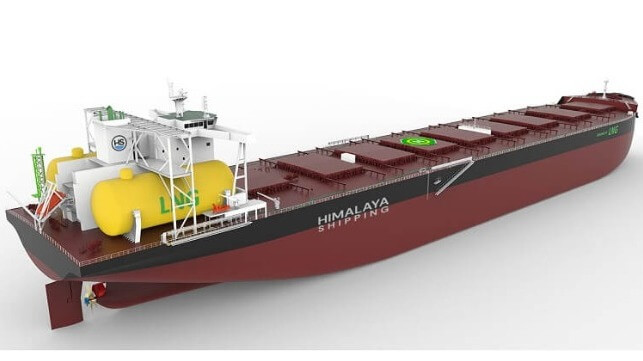12 New LNG Bulkers Will Be Equipped to Burn HFO

The independent bulker operator Himalaya Shipping plans to install scrubbers on a fleet of 12 LNG-powered Newcastlemax bulkers currently under construction at New Times Shipyard (NTS) in China.
The installation acknowledges the reality of LNG dual-fuel power today: LNG is so expensive that most LNG-fueled oceangoing ships have switched to VLSFO. The addition of a sulfur scrubber - while unnecessary for running on LNG - will allow these bulkers to operate on the least-cost conventional fuel, HFO.
Himalaya, which in April listed on the Euronext Expand exchange, has in recent months completed a sale leaseback agreement to secure financing for the newbuilds. The vessels will deliver in 2023-24.
After installation of scrubbers, the ships will have the ability to be fueled with liquefied natural gas (LNG), low sulfur fuel oil (LSFO) or high sulfur fuel oil (HSFO). Himalaya says that the installation of scrubbers offers "significant increased flexibility for its customers and will be valuable in the ongoing employment discussions."
Based on current spot pricing of LSFO versus heavy fuel oil (HFO) in Singapore, the scrubber investment is estimated to give a total benefit of $7,500 per day when sailing. Based on the company’s expected share of scrubber benefit, the investment is expected to be paid back in less than one and half years.
“The management and board would like to express their appreciation to NTS showing their willingness and ability to make alterations during the building process, underlining the excellent cooperation between builders and the company,” said Herman Billung, Himalaya Shipping CEO.
The 12 208,000 dwt Newcastlemax dry bulk vessels are designed to burn LNG as primary fuel, and they have the latest generation MAN high pressure engine and in-line shaft generator. The ships are estimated to reduce greenhouse gases emission by approximately 60 percent per tonne mile compared to a standard 2013-built 180,000 dwt Capesize, due to higher cargo carrying capacity.
Scrubbers enable compliance with the IMO 2020 sulfur emissions standards without using very low sulfur fuel. At present, about 4.2 percent of the global shipping fleet has been fitted with scrubbing technology.
